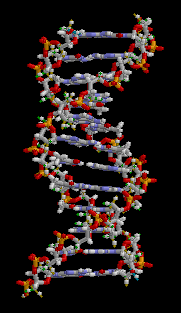I don’t think many people have any idea how far we’ve come. Because I like to keep track of scientific and technological developments as part of writing science fiction, I have a better idea than most, but then a story like this one comes across my desktop and I’m left in disbelief.
It has only been sixty years since the structure of DNA was understood, and now researchers at Stanford University have figured out how to write, read, and rewrite bits of information on DNA itself, making DNA an information storage device. When I say bits, I mean bits – they haven’t managed a full byte (eight bits) yet.
Still, it’s pretty amazing. They use two proteins – integrase and excisionase – and by getting the balance between the two right, can reliably switch the direction of a section of DNA. The DNA in question was within the chromosomes of the favorite of biological researchers – E. coli.
Now, as usual, I’m a bit worried about what use we might eventually put this to, though for once this is a discovery that seems more useful than dangerous. Instead of Johnny Mnemonic having some sort of hard drive in his brain, he’ll just have some modified DNA meant to store information. Sort of more natural, isn’t it? Maybe in the future, we’ll actually incorporate this kind of storage into part of our brains, readable by brain processes but only writable with some sort of protein device. That way, we can permanently store information that we desperately don’t want to forget, like passwords and the like. You never know.
But, of course, this technology is also critical to creating semi-biological procreating nanobots. We would be able to add a program directly into a nanobot‘s DNA and have it replicate at our whim, performing its assigned task (as long as no mutations occur, and they will, leading to our inevitable destruction). So, there is a dark side to all this.
What does Dr. Drew Endy, the senior researcher, think about the uses this technology might be put to? “I’m not even really concerned with the ways genetic data storage might be useful down the road, only in creating scalable and reliable biological bits as soon as possible,” he says. Ah, typical. Just plow on ahead without thinking about what kind of world your research might lead to. Do you know how many technology-gone-awry stories have started with thinking, or lack thereof, like that? That’s right – practically all of them.
Just kidding. I think what Dr. Endy and his team has done is amazing and congratulate them on their success. I think anyone with an ounce of imagination can see that this could be very useful down the road, even if it isn’t incorporated into some larger organism. After all, DNA is one of the most efficient methods of information storage ever devised, and our pace of information creation is still accelerating.

